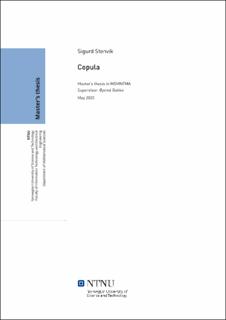| dc.contributor.advisor | Bakke, Øyvind | |
| dc.contributor.author | Stenvik, Sigurd | |
| dc.date.accessioned | 2021-09-15T17:25:17Z | |
| dc.date.available | 2021-09-15T17:25:17Z | |
| dc.date.issued | 2020 | |
| dc.identifier | no.ntnu:inspera:53287260:34466076 | |
| dc.identifier.uri | https://hdl.handle.net/11250/2778324 | |
| dc.description.abstract | Copulaen er et interessant verktøy i statistikken. Den er brukt i mange forskjellige områder fra finans til klimamodeller. En stor grunn til at copulaen er nyttig er hvordan man kan bruke copulaen til å splitte en bivariat fordeling opp i avhengighets-strukturen og selve marginalfordelingene. Vi vil forklare dette i denne oppgaven. Hvis du for første gang ser på definisjonen til copulaen kan det være vanskelig å forstå hva copulaen egentlig er. Derfor har vi gitt en foklaring på hva en copula er i form av sansynlighetsfordelinger, som burde være intuitiv for en person som allerde har litt kunnskap om statistikk. Vi skriver også om sklars teorem, som teoretisk forklarer denne sammenhengen mellom den bivariate fordelingen, dens marginalfordelinger og avhengighetsstrukturen mellom marginalfordelingene. Vi generaliserer også denne teorien fra $2$ til $n$ dimensjoner, og vi forklarer hvordan man kan estimere parameterne til en copula. Vi avslutter oppgaven med å vise hvordan man kan bruke en copula til å simulere fra en bivariat fordeling. | |
| dc.description.abstract | The copula is a very interesting tool in statistics. It's used in many setting from quantitative finance to climate models. Copulas are to a large extent useful because they can elegantly separate the dependence structure from marginal distributions in a multivariate distribution. We will explain this in detail in the thesis. If you for the first time look at the definition of a copula it might be difficult to understand what a copula actually is. Therefore, we also give a description of the copula function in terms of distribution function, which is intuitive for someone with some prior knowledge of statistics. We also write about Sklar's Theorem, which theoretically explains the connection between the bivariate distribution, its marginal distributions and the copula. Next we generalise the theory of the copula from 2 to $n$ dimensions, and we also show how to estimate the parameters of a copula. Finally, we show how you can use the copula to simulate samples from a bivariate distribution. | |
| dc.language | | |
| dc.publisher | NTNU | |
| dc.title | Copula | |
| dc.type | Master thesis | |
